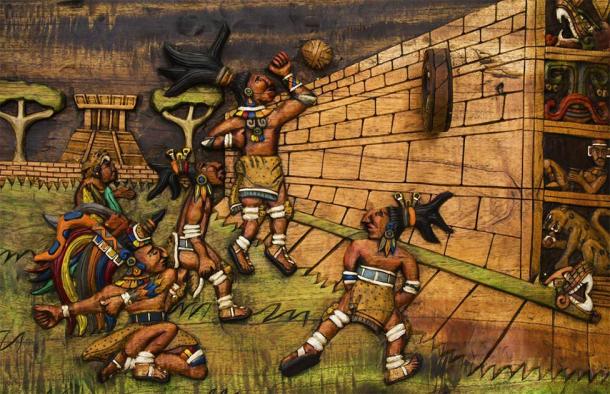Researchers believe that they have found the oldest balls ever uncovered in Eurasia. The set of leather balls were found in graves of Central Asian horse riders in northern China. They are offering evidence that ball games were played some 3000 years ago. It is believed that not only were ball games important but played a role in the rise of Central Asian equestrian societies.
The amazing discovery was made during excavations of a burial site near Turfan in Northern China, known as Yanghai. According to the New Scientist ‘The Yanghai cemetery, which contains more than 500, was in use between about 3200 and 1850 years ago’. Many of those interred there were horsemen, associating it with an equestrian society of Central Asia.

The area near the city of Turfan in northwest China. ( UZH)
Leather balls 500 years earlier than known
During the excavations, three balls that are made of leather were found. The balls’ diameters all measure between 2.5 to 3 inches (7.4 and 9.2cm) and they were dated by researchers using AMS radiocarbon dating which found that they were up to 3200 years old. The media release by University of Zurich quotes Patrick Wertmann as saying that ‘This makes these balls about five centuries older than the previously known ancient balls and depictions of ball games in Eurasia’.

The three leather balls with diameters between 7.4 and 9.2 cm are between 3200 and 2900 years old. ( UZH)
For comparison, the oldest known balls ever found were made in Egypt. They were made out of tied bundles of linen and are 4,500 years old. It is generally held that Pre-Columbian Mesoamerican societies, such as the Olmecs developed rubber balls about 3500 years ago. ‘Until now, it was believed that Europe and Asia followed much later: Greece some 2,500 years ago and China about 300 years later’ reports the University of Zurich .
History of ball games
The dating of the Yanhai balls challenges this narrative about the history of the development of the ball. The researchers wrote in the Journal of Archaeological Science that these ‘predate other currently known antique balls and images of ball games in Eurasia by several centuries’. Therefore, Central Asia societies were making and playing with balls much earlier than believed.
In the Journal of Archaeological Science , the researchers state that:
‘Our study approves the antiquity of the Yanghai balls, but the available data is not enough to answer the question how these balls were played’.
Paintings from Greece and elsewhere show that sticks were used in ball games, rather like hockey. Indeed, some sticks, that may have been used in sports have been found in the Yanghai cemetery.

Representation of the ancient Mesoamerican ball game being played on the Great Ballcourt at Chichen Itza . ( pop_gino /Adobe Stock)
Mystery of an ancient ball game
This raised the possibility that the balls may have been used in a sport similar to polo, as sticks have also been found at the cemetery. Patrick Wertmann is quoted in the release as saying that ‘Unfortunately, however, the associated archaeological information is not sufficient to answer the question of exactly how these balls were played’. Moreover, the sticks found in the burial grounds come from a much later date than the balls. As a result, it seems unlikely these implements were used to play sports that involve sticks and balls. Wertmann stated that ‘Therefore, the Yanghai leather balls do not extend the history of hockey or polo’.

Base of a funerary kouros, found in Kerameikos, built into Themistokleian wall. Decorated with what appear to be players of a game similar to hockey. (Zde / CC BY-SA 3.0 )
However, the balls do indicate that the equestrian society did play some form of sport. Like, the modern age, sport was both entertainment and had an important social function. The artifacts were indicative of a new era in Central Asia linked to environmental changes and the widespread adoption of the horse. In one of the burials was also found a composite bow and a pair of trousers and these are some of the earliest known.
Central Asian equestrian societies
The University of Zurich argues that ‘Both are signs of a new era of horseback riding, horse-riding, and fundamental social change’. The balls were not just playthings. It seems likely that the leather objects and the games associated with them were mainly used for physical training. Moreover, the ballgames may have been used as a form of military training.
The discovery of the artifacts offers an important insight into the history of Central Asia some 3000 years ago. This and other finds in the burial grounds show that it was societies in the region were very innovative. Moreover, it shows that the equestrian societies that ranged over Central Asia were much more advanced and sophisticated than often thought.
Find out more about ancient games and gameplay in the Ancient Origins Magazine Special here.
Top image: Leather balls thought to belong to horsemen of Northern China have been found. Source: 孝通 葛 / Adobe Stock
By Ed Whelan
Related posts:
Views: 0
 RSS Feed
RSS Feed

















 October 13th, 2020
October 13th, 2020  Awake Goy
Awake Goy 
 Posted in
Posted in  Tags:
Tags: 
















